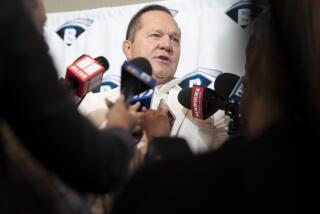A COMPARISON OF FREE AGENT RULES
- Share via
MAJOR LEAGUE BASEBALL
Players with six or more years of major league service are eligible. Free agents are divided into three categories:
--Type A (those who rank in the top 20 percent according to a statistical comparison).
--Type B (those who rank from 20 to 30 percent) and those not requiring compensation.
A club losing a Type A or Type B player receives a first- or second-round amateur draft pick from the player’s new club, depending on how many free agents the new club has signed and whether the player is Type A or Type B. In addition, the former club receives an extra pick between the first and second rounds.
NATIONAL BASKETBALL ASSN.
All players are eligible. A club wishing to sign a player gives an offer sheet. The player’s former club has the right to match the offer and keep the player. Agreement expired June 17.
NATIONAL FOOTBALL LEAGUE
Players are divided into three groups according to a sliding salary scale:
--Group One. No compensation. Those with a third-year salary below $80,000 up to those with a 14th-year salary below $185,000.
--Group Two. Old club has right of first refusal: All first- and second-year players. Those with third-year salaries between $80,001 and $100,000 up to 14th-year players between 185,001 and 209,000.
--Group Three. Those requiring compensation. The following scale is used (first figure is maximum salary in group for third-year players; second figure is maximum salary in group for 14th-year players. For players between their third and 14th year, the figure is in between):
$120,000 to $230,000: third-round draft pick; $140,000 to $250,000: second-round draft pick; $180,000 to $290,000: first-round draft pick; $230,000 to $340,000: first- and third-round draft picks; $280,000 to $390,000: first and second-round draft picks; Above $390,000; two first-round picks.
Agreement expired Aug. 31
NATIONAL HOCKEY LEAGUE
All players are eligible. Players are divided into three groups.
For players younger than 24 years and with less than five years professional experience, clubs attempt to reach a mutual agreement on compensation. If they cannot agree, the matter is submitted to binding arbitration and the arbitrator must choose either one club’s offer or the other’s
For players between 24 and 31 with at least five years of professional experience, the compensation depends on how much higher the new club’s offer is over the old club’s offer. (If the old club does not offer at least a 15 percent increase, no compensation is required.) Compensation is determined by the following scale:
$110,000 or less: No compensation; $110,001 to $135,000: third-round draft pick; $135,001 to $160,000: second- and third-round draft picks; $160,001 to $210,000: first-round draft pick; $210,001 to $260,000: first- and second-round draft picks; $260,001 to $400,000: $100,000 and two-first round draft picks (three if one is not in the first 11 of the draft); $400,001 or more: $100,000 and two-first round draft picks (three if both are not in the first seven of the draft).
For players older than 31, if a club offers a least a 15 percent salary increase, it is entitled to compensation. The player chooses whether his old club shall have right of first refusal to match the salary offered by the new club, or if the old club will receive compensation. If the clubs cannot agree on compensation, the matter is submitted to binding arbitration and the arbitrator must choose either one club’s offer or the other’s.
More to Read
Go beyond the scoreboard
Get the latest on L.A.'s teams in the daily Sports Report newsletter.
You may occasionally receive promotional content from the Los Angeles Times.










